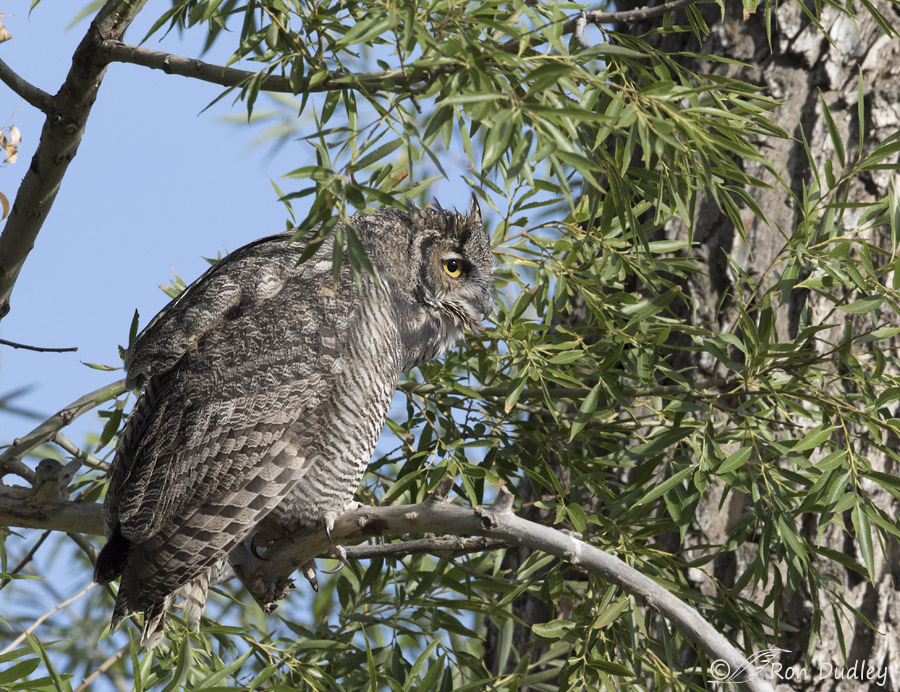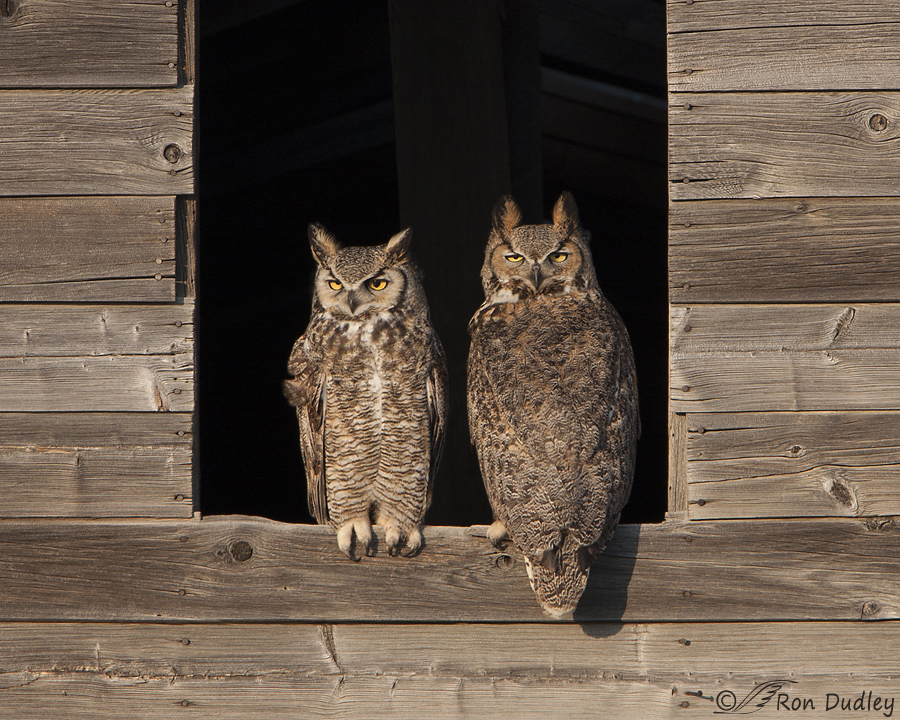Most of the Great Horned Owls I post were photographed in Montana. This one’s from Utah and I believe it demonstrates some interesting geographic variation in color.
 1/1250, f/8, ISO 400, Canon 7D Mark II, Canon EF500mm f/4L IS II USM, not baited, set up or called in
1/1250, f/8, ISO 400, Canon 7D Mark II, Canon EF500mm f/4L IS II USM, not baited, set up or called in
I photographed this bird just over a week ago close to the Utah/Idaho border near Snowville, Utah. It’s in a busy but typical setting for the species. I chose to post this pose because most of the time the owl was standing more erect which placed the hanging cluster of leaves in the foreground directly in front of its face. There was another owl just out of frame to the left but it was buried in the leaves and I barely got a glimpse of it.
I was struck by the plumage colors of this owl. Most (if not all) of the GHO’s I’ve seen have significant portions of their plumage that are brown, or tawny (orange-brown to yellowish brown) but this one lacks those colors (except for a little on the face) and is almost entirely darker shades of gray and grayish-white.
Great Horned Owls are non-migratory and as a result they have developed significant and complex geographic variation in appearance. Up to 15 supspecies are recognized in the Americas.
I’m no expert on owl plumage colors and I doubt that this bird is atypical but it’s different from what I usually see and I found that interesting.
Ron
Addendum: I’m posting this second image in response to Arwen’s comment below so folks can compare the colors on the first bird to what I more typically see. This is a mated pair of Great Horned Owls in northern Montana with the larger female on the right. I tried to pick an image where the color of the birds wasn’t influenced by extremely warm light. To my eye the dominant overall color of the first bird is gray while the primary color of the birds below is brown to tawny.



Great comparison. There are several subspecies of Great Horned Owl in the region, with subtle differences in overall color, but the subspecies names and boundaries are fairly arbitrary lines on a more gradual variation. In general the owls are darker and grayer to the south and west (the single bird in the willow from northern Utah) and paler and more tawny to the north (the pair in the barn from northern Montana).
There is also a lot of individual variation, but a lot of that is accounted for by the sex of the owl. In the pair in the barn it is the female (larger) on the right that shows a lot more rufous and buff color, and a little darker than the male. Compare the colors of the face and ear tufts on those two birds. Then comparing the single bird from Utah, which is likely a male, to the male from Montana: it is darker and grayer than the Montana male as expected.
I think there is plenty of overlap in color, these are average differences and change gradually across hundreds of miles, but accounting for the sex of the owl makes it a lot clearer.
I was blown away by this image when you posted it while you were away.
Such a tactile image. My fingers just ‘know’ how soft that plumage is. It looks like the softest, most comforting crochet. I am well aware that my fingers are wrong – but they are arguing the point.
And thank for for adding the colour comparison image.
Loved how you described your reaction to the apparent softness of the plumage of the owl, EC.
Interesting post, Ron! A geographical difference certainly makes sense. A review of my (few and poor) horned owl shots show what seems to be a fairly even mix of mottled gray and brown and most of the faces have quite a tawny look.
Thanks again for my continuing education!
Interesting report on the colors you see in this species in Florida, Wally. Thank you.
When I have attended NWRA workshops in Oregon and Seattle we use birds that have died in rehab situations for learning triage of injured wildlife. I am always shocked at how dark all the birds are compared to Utah. The GHO are a sooty charcoal black. Even the robins are dark black. Our light tawny GHO would stick out like a white ghost in the forests of the northwest.
That fits with what BNA says, April (see Ed’s comment below).
Interesting Ron and the timing of article is perfect as I was recently thinking about the differences in coloring that I have been seeing in GHOW’s. A few weeks ago I was treated to some very close looks of a family of them in Katmai National Park Alaska while kayaking. The camera was stowed away in the kayak, so no photos unfortunately of these very white colored owls. Similarly I saw a very light (whitish) Great Horned Owl a few years ago up at 12,400 feet elevation in New Mexico. I wonder if the ones that live in northern latitudes or high elevations were lighter colored due to more snow in these regions? Cornell’s Birds of North America online (BNA) discuss the color variation and attribute the color variation to humidity of the region (arid or snow –> lighter color, higher humidity or forests –> darker color). I guess that agrees with my experience as I have also seen very light colors in the desert. I will keep a closer eye out now on the color, thanks for your article and peaking my interest. One can read the Cornell BNA info here –> http://bna.birds.cornell.edu/bna/species/372/articles/systematics
Interesting about those very light colored owls you’ve observed, Ed. I’ve never seen GHO’s of that color. I actually used BNA Online in my research for this post but missed the article on systematics that you linked to. That was also quite interesting. Thank you.
BTW Ron, your photo of the two Great Horned Owls in the barn window is GREAT! I love their markings alongside the weathered wood and their different head positions. Very nice!
Definitely a marked variation in color. I think a lot of animals have color variation, and for different reasons. I know some of the lizards we see are a much darker color when they are living on dark-colored rocks. It occurs to me that with owls, it might have something to do with the kind of trees they live in, so they are more camouflaged in winter? Just a thought.
Could be, Susan. I suspect there are multiple selection pressures that account for these color variations.
As you know Ron, for that variation to occur there must be some hint (genetic hint) in the parents of this offspring. By any chance do you have images of the parents.
This is certainly an interesting variation and I agree with you, here in the East from my observation, this is not the colors that I normally see in our area either.
I’ve been out of touch for a few years, do you know anyone that is doing DNA studies on birds, specifically Great Horned Owls and their variations? What a great project for an up and coming Ornithologist!
Dick, I’m afraid that the answer to both of your questions is no.
The life span of this species is up to 28 years and as far as I know the adult owls on the Montana farm (second image) have been the same birds for about 20 years and since their youngsters always disperse to another area I’ve never been able to compare parents to adult offspring.
And I don’t know anyone who is doing those DNA studies but I suspect someone is, somewhere…
Darn, that is too bad. Banding would help, but keep on taking those images, someday they may come in handy to someone!
Very interesting stuff Ron, at least to me!
Thanks for sharing!!
Thank you, Dick.
Great shot and very nteresting. I live in MO and the color differences between the ones here and the one in your shot is remarkanle.
Charlotte
Thanks for that observation, Charlotte.
Another thing learned. I did not know that coloring fact. I’d love to see a post with the different owls so I could see that difference.
“I’d love to see a post with the different owls so I could see that difference.”
Done.
You rock, Professor. And yes, there is a distinct difference in coloring there. I guess now I’m on a hunt to see all the varieties.
And yes, there is a distinct difference in coloring there. I guess now I’m on a hunt to see all the varieties. 